Abstract
In recent years, both anthropogenic and climate changes have caused the depletion of surface water resources, shifts in rainfall and accelerations in temperature, which indicates the importance of their examination to flood forecasting analyses. This paper studies the importance of synchronised water management strategies, considering upstream and downstream dynamics using field data from 1986 to 2018. Seasonal and decadal variations show the need for adaptive management strategies to address potential climate change impacts on discharge, precipitation and temperature patterns in the Zarrinehrud River, Iran. The regression analysis was considered via R2 values, and the statistical analysis was regarded by p-values. The regression analysis of monthly river peak discharge indicates strong correlations between the discharge of specific months (September–October upstream, December–January downstream). By the 2000s and 2020s, both stations showed a shift in peak precipitation to the spring months (April–May for upstream and May–June for downstream). This confirms a synchronisation of rainfall trends, which are influenced by climate changes or regional hydrological patterns. This temporal offset between stations confirms the spatial and seasonal variation in rainfall distribution across the basin. Higher temperatures during the dominant months, particularly late summer to early autumn, accelerate snowmelt from upstream catchments. This aligns with the river discharge peaks observed in the hydrograph. The statistical analysis of river peak discharge indicated that the Weibull (p-value = 0.0901) and the Lognormal (p-value = 0.1736) distributions are the best fitted distributions for the upstream and downstream stations, respectively.
1. Introduction
Population growth and climate change play a key role in influencing water resources globally [1]. Climate change has caused intense droughts and flooding events over the years. It has inevitable impacts on the water cycle by altering precipitation patterns and increasing temperatures [2]. In recent years, both anthropogenic and climate changes have caused the depletion of surface water resources, shifts in rainfall and accelerations of temperature, which indicates the importance of their examination to flood forecasting analyses [3,4]. There are two strategies to cope with flood hazards: (i) non-structural methods, including real-time flood forecasting with numerical methods to assist decision makers, and (ii) structural methods by building protection measures like dikes and dams [5]. Numerous studies have investigated the effects of climatic factors on river behaviour, particularly in flood-prone basins. Lake Urmia, the world’s second-largest salt lake, located in the northwest of Iran, encounters too many environmental challenges. Addressing the escalating impacts of climate change and human activities while considering the construction of dams along the rivers that flow into the lake, which are entwined in domestic and agricultural developments, has caused an increase in water demands in recent decades. The water level of the lake has plunged into a great decrease of 90% in a 15-year span from 2000 to 2015 [6,7]. Due to the continuous degradation of the water level and droughts at the Lake Urmia Basin (LUB), studying one of its prominent rivers, the Zarrinehrud River, would have profound significance in comprehending its future environmental conditions. The hydrometric stations used in this study are located at a significant distance from the dam structures to reduce the direct operational impact on the discharge readings, thereby allowing for a more representative analysis of the river’s downstream behaviour. Many researchers have considered the river peak discharge, precipitation and temperature for flood forecasting to reduce the uncertainties in hydrological and hydraulics modelling for various rivers [8,9,10,11].
Kumar et al. [12] described sediment flow transportation parameters using machine-learning techniques to look at sediment transportation. The distribution of suspended sediment over the characteristic height inside the flow was compared with other experimental data in the same way as it is investigated on data in this study to perform a comparison. Therefore, it is essential to conduct data analyses before any further examination of data, like historical data modelling. There are several flood forecasting methods, which introduce different data types. Kazemi Garajeh et al. [2] studied the increases in air temperature (AT) and evapotranspiration (ET) in the LUB, Iran, between 2000 and 2021. A decline in annual precipitation occurred, as evidenced by the negative correlation between AT, ET and water surface area. The findings of this study indicated correlation coefficients of −0.55, −0.59 and 0.39 between the water area, AT, ET and precipitation, respectively. According to the results in their study, climate change has affected water resources from 1984 to 2021 in the LUB, as the same years are partly involved in this study. Asadi et al. [6] employed the following daily hydrological alterations: precipitation, temperature, streamflow and land use for 24 years during the years 1995–2019 to investigate the implementation of environmental flow in a water allocation model and analyse water demand reliabilities at the Zarrinehrud River Basin, Iran, using SWAT+, WEAP and IAHRIS. They emphasised the changes to the hydrological regime caused by the Bukan dam. Their research covers the same years of this study and also explains the crucial role of the Bukan dam while investigating months with river peak discharge.
Toth et al. [13] considered past rainfall depth as a sole input to compare the accuracy of the short-term rainfall forecasts obtained with time-series analysis techniques, including linear stochastic auto-regressive moving average (ARMA) models, artificial neural networks (ANN) and the non-parametric nearest-neighbours method for forecasting storm rainfalls that occurred in the Sieve River basin, Italy, in the period of 1992–1996. The overall results show that even if the rainfall forecasting performance measures indicate only a weak-to-moderate relationship between the forecasted and observed values, considering time-series analysis techniques provides an improvement in flood forecasting accuracy. It was concluded that past rainfalls alone are not sufficient to make precipitation projections. Therefore, precipitation, temperature and river peak discharge would be more suitable inputs for flood forecasting, and the historical data are analysed in this paper. Te Linde et al. [14] explored flood management for the year 2050 along the Rhine River basin, as a cross-boundary river located in northwest Europe, which was determined between the upstream and downstream. It was planned to simulate long discharge series (10,000 years) to estimate peak discharge with a low probability of flooding events using flood waves at four locations with four return periods. They indicated that upstream flooding has a profound decreasing effect on the simulated peak water levels and discharges along the main Rhine branch and downstream in the Netherlands, where there are two hydrometric stations located upstream and downstream of the river. These stations were selected to perform flood management in this study as well. Supriya et al. [15] investigated the regression analysis at the Vellar river basin in South India by annual maximum daily rainfall, stream flow and area for each catchment. A Multiple Regression Model (MLR) was used to understand the relationship between the weighted annual maximum daily rainfall, catchment area and annual maximum daily stream flow. It was found that a regression analysis is an effective statistical method for flood forecasting techniques based on catchment characteristics, and this technique is the basis of this paper’s discussion.
Shirmohammadi et al. [16] studied the effects of climate change on stream flow variation in the LUB, Iran, by using daily statistics, including precipitation, minimum and maximum temperature and runoff during the base period (1981–2010). The performance analysis of the observed and simulated data indicated that the LUB faces decreasing stream flows, declining precipitation and rising temperatures in the future. Their findings confirmed the importance of data analysis to create scenarios to generate projections. Behboudian et al. [17] assessed the impacts of climate change using daily precipitation and minimum–maximum air temperature for the period of 2019–2049 in the Zarrinehrud River Basin, Iran. To simulate various climate change scenarios, a SWAT model was used to simulate the rainfall-runoff processes and evaluate land management practices from two hydrometric stations: upstream (33023) and downstream (33917). They provided the time series of the monthly inflow to the reservoir from 2019 to 2049. They concluded that the priority order of the water demand supply is municipal, industrial, environmental and agricultural, with the drinking water demand projected to increase by 50%. Additionally, drought resilience was found to be as equally important as flood management in this region. Kazemi Garajeh et al. [18] explored the anthropogenic activities on surface water resources across the LUB, Iran. Air temperature, cropland, potential evapotranspiration, snow cover, precipitation, built-up areas and groundwater salinity data acquired from 2000 to 2021 were considered and imported using implemented code on the Google Earth Engine (GEE) platform. The Mann–Kendall (MK) non-parametric trend test and Pearson correlation analysis were conducted for the evaluation of the results. Climatic factors such as air temperature, potential evapotranspiration, precipitation and snow cover demonstrate negative correlations of −0.56 and −0.09 for air temperature and snow cover, with surface water resources being identified as the main elements to employ for flood forecasting. Kumar et al. [19] investigated geomorphological alterations due to climate change and anthropogenic causes in the Gandak River, which is located in Nepal and merges with the Ganga River in India. They analysed river migration from 1989 to 2022. It was observed that erosion and river shifting are progressing at many locations, and many villages were wiped off during the floods. There are several similarities with these papers and this study that can be indicated: (i) selecting an upstream and downstream hydrometric station as a benchmark to perform comparisons, (ii) more than 30 years of available data and (iii) employing river peak discharge and climatic data like precipitation and air temperature, predominantly for flood forecasting purposes.
The objective of this study is to use river peak discharge data as the inflow data while using precipitation and temperature data as the climatic data to understand their trends during recent decades and assess how the weather paradigm affects the river’s behaviour. In this study, 33 years of historical data (from 1986 to 2018) for the Zarrinehrud River, Iran, located in one of the most vulnerable basins in the world, the LUB, is considered to explore approaches for effective flood management. To minimise the impact of dams on the investigated data, a sufficient distance from those dams to the measuring stations was kept. Moreover, the potential influence of dam regulation has been thoroughly acknowledged and fully discussed in the Results and Discussions Section to provide clarity on the interpretation of the observed discharge patterns. Unlike studies that focus primarily on projections, this paper focuses on examining the historical records to understand past behaviours, identify key influencing factors such as climatic changes and dam impacts, and determine the dominant months that are prone to potential flooding events for better preparedness in future modelling efforts.
2. Materials and Methods
2.1. Study Area
This case study is located in the northwest of Iran and encompasses the Lake Urmia Basin (LUB), a crucial geographical and ecological region covering a land area of 51,876 km2. LU occupies 10% of the area, which is depicted in Figure 1 [16]. This terminal relies on water inflow from 17 permanent and 12 seasonal rivers, and the main part of this river is located in Shahin Dej county, Iran. The case study highlights the significance of this region in terms of its environmental and hydrological characteristics [16]. In particular, the Zarrinehrud River, serving as one of the primary inflows among those rivers, contributes 41% of the surface water flow into Lake Urmia [17]. Lake Urmia, encompassing an expanse of 6000 km2, is the world’s second-largest hypersaline lake, where the Zarrinehrud River is located at the lowest point of the LUB [18]. Over the years, the lake’s size has been greatly reduced due to multiple factors, including excessive agricultural water usage, river dams and droughts from climate change impacts [19]. The LUB region is considered a semi-arid and dry-cold climate with an average annual rainfall of 359 mm, a minimum temperature of 4.3 °C and a maximum temperature of 17.7 °C [20]. The evaporation rates show a range from 930 to 1513 mm per year [21]. The Zarrinehrud River basin, with a land area of 12,000 km2, extends for 320 km. The region comprises semi-cold-wet or cold-wet conditions in mountainous areas and semi-dry conditions near Lake Urmia. The rainfall within the basin varies between 200–800 mm/yr [20,21]. Lake Urmia’s inflow comprises 25% from direct precipitation and 75% from 60 permanent or seasonal rivers [22], which makes it important to study one of them.
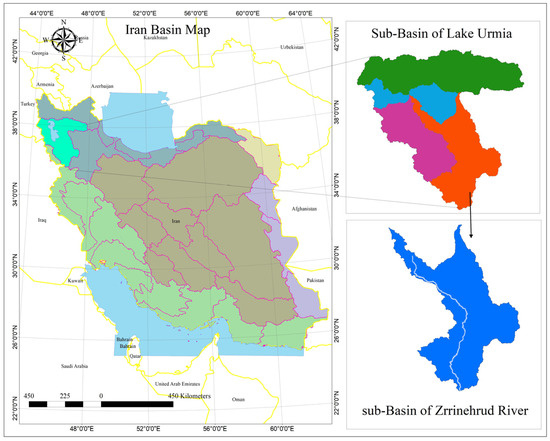
Figure 1.
Case study—Zarrineh-Rood River, West Azerbaijan, Iran.
The Zarrinehrud River’s hydrometric stations are going to be introduced as the upstream-33023 and downstream-33917 stations throughout this study and are shown in Figure 2. The upstream-33023 station is located 5 kilometres down from the Bukan Dam, and the downstream-33917 station, as the ultimate station of the Zarrinehrud River basin, is located after the Nowruzlu dam. The Nowruzlu dam is located 70 km downstream of the Bukan Dam. At this dam, the right and left bank canals are used to supply drinking water to the city of Tabriz and the surrounding areas, respectively. Between the Bukan Dam and the Nowruzlu Dam, eight seasonal rivers named Qoreh Chai, Holasu, Hachasu, Aghche, Joshato, Sourin, Ajarlu and Qoreh Chai connect to the Zarrinehrud River. The Nowruzlu diversion dam was built on the Zarrinehrud River to control floods in this river and for agricultural and industrial purposes [23,24]. In Figure 2, the locations of Lake Urmia and the Zarrinehrud River are imported from Google Maps, and the locations of the Bukan dam, Upstream-33023 station, Nowruzlu dam and downstream-33917 station are illustrated.
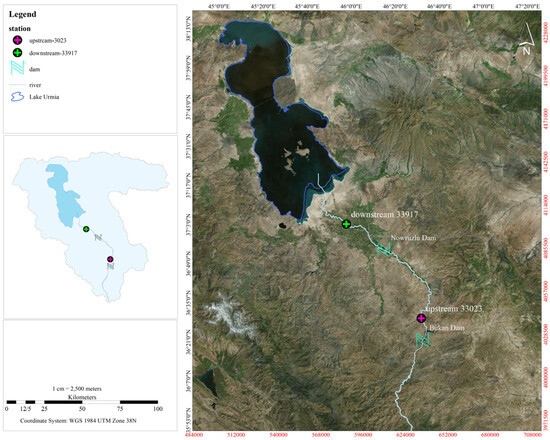
Figure 2.
Location of hydro-climatic stations and dams along the river.
2.2. Dataset
Herein, four datasets, including annual river peak discharge, monthly river peak discharge, monthly precipitation, and monthly temperature of the upstream-33023 and downstream-33917 stations, are employed for the years between 1986 and 2018. These datasets were acquired from the Regional Water Organisation of West Azarbaijan, Iran. Two methodological challenges exist for hydrological data analyses in the Zarrinehrud River: (i) there is a short period of data available to conduct surveys, which would lead to some uncertainties and analysis pulses, and (ii) in the last decades, both the climatic patterns and the river basin have shifted. This paper will use the thirty-three years of data spanning from 1986 to 2018, which contains the 1990s, 2000s and 2010s, to examine the potential components for flood forecasting through the Zarrinehrud River. The reason for selecting the upstream-33023 and downstream-33917 stations was due to the existence of two important dams: the Bukan dam at the upstream and Nowruzlu dam at the downstream, which are noteworthy to analyse the river flow’s behaviour and investigate the affected data throughout the years in this region.
2.3. Data Analysis
In this paper, the calibration process began with analysing the hydrographs of the upstream-33023 and downstream-33917 stations. The hydrographs were used to explore the behaviour of the water inflow (i.e., extremes or droughts) along the river between both the upstream and downstream stations. To address projections, the historical river peak discharges were examined to extract dominant months to understand the data trends. The validation of the data was conducted via regression analysis. Climate change led to evolving flood management in this region. To overcome the potential changes, two stations were selected to perform the comparison and conduct a statistical exploration of regional data as a benchmark, and the target was to illustrate the trends of the annual river peak discharge hydrographs, monthly river peak discharge, monthly precipitation and monthly temperature, and study the correlation between those historical data to discuss their interaction effects throughout the years for further simulation processes. This study aims to initially analyse the observed data and distinguish between dominant months to create scenarios and make projections.
Validation of Data
To study flooding on the Zarrinehrud River, Iran, the river peak discharge (m3/sec) was requested for an available period as dependent data, and accordingly, the independent data, including precipitation (mm) and temperature (°C), were employed. The real-time data experienced a preparatory phase in this study, allowing us to understand the river’s behaviour without any manipulation before delving into modelling. Due to this, the regression analysis was considered via R2 data values, and the statistical analysis was regarded by p-values on the real monthly river peak discharge as a dependent variable, including Normal, Lognormal, Gamma and Weibull, which were extracted for the upstream and downstream stations to check the skewness of the data and complete an initial visual fitting. Meanwhile, the goodness of fit tests, the Kolmogorov–Smirnov (K–S) test and Anderson–Darling (A–D) test, and the trend analysis tests, the Mann–Kendall test and Sen’s Slope Estimator, were applied considering p-values. Those statistical tests are all indicated in Table 1.

Table 1.
The statistical tests.
3. Results and Discussion
Scientists have highlighted the necessity of collecting more accurate data to reduce the uncertainties in hydrological and hydraulics analyses. For practical flood forecasting, the first step is to identify data and its time step and investigate the river flow’s behaviour like in [2,4,6]. The objective of this paper is to study the capability of the data, particularly the accuracy of its representative factors and the way climate change affects flood management. For flood forecasting in the Zarrinehrud River, Iran, both the upstream-33023 and downstream-33917 stations play a key role. The annual river peak discharge, monthly river peak discharge, monthly precipitation and monthly temperature of those stations in recent decades were analysed spanning from 1986 to 2018 in further sections. The upstream-33023 station shows more direct control by the Bukan Dam, leading to more regulated discharge patterns, which aligns with the findings of [6], and on the other hand, the downstream-33917 station has higher variability due to the contributions from the seasonal rivers and the influence of the Nowruzlu Dam.
3.1. Annual River Peak Discharge Hydrographs
Figure 3 illustrates the annual river flow rate for each hydrometric station. The river peak discharges for both stations have an almost identical range, considering their geographical features. The flow pattern in Figure 3 shows the fluctuations of the upstream-33023 station over the years, with notable peaks around 1996, with the value of 690 m3/s. This station is influenced by releases from the Bukan Dam, suggesting controlled regulation of water flow. Given the significant distance of the measurement stations from the dams, the impact of dam operations on discharge readings is minimised. While detailed operational records were unavailable, the influence of dam regulation has been thoroughly discussed to support the validity of the statistical characterisation of the managed flow regime. Due to this, the variability in discharge suggests the dam’s operation plays a critical role in regulating the upstream flow [6]. Considering the downstream-33917 station’s graph, it shows similar peaks in the discharge, but the magnitude and timing of the peaks slightly differ compared to the upstream-33023 station. This could be due to the presence of seasonal rivers and contributions from the tributaries between the dams, adding complexity to the flow, and the hydrograph also highlights the downstream-33023 station’s role in flood control and its potential to manage seasonal variability. It is concluded that at the upstream-33023 station, the variability in the peak discharge shows that the Bukan Dam likely moderates seasonal flows to reduce floods during wet seasons and supplement water during dry periods. Some years exhibit very low or almost negligible peaks (e.g., mid-2000s). This may be indicative of drought conditions or operational constraints at the dam.

Figure 3.
Hydrographs of upstream-33023 and downstream-33917 stations of Zarrinehrud River.
The highest peaks (e.g., early 1990s and 2015) align with potential periods of heavy rainfall or dam releases for flood control or irrigation demand. It is notable that the hydrograph of the downstream-33917 station demonstrates higher variability than the upstream-33023 station, especially during wet years. Seasonal rivers likely contribute to sudden spikes in flow during the rainy season (spring or fall), amplifying the downstream discharge. Peaks like those in 1995, 2015 and 2018 appear to correspond with upstream peaks, but with added contribution from seasonal rivers. Particularly, the alignment or misalignment of peak years between the stations shows how tributaries and dams interact to influence the flow behaviour. Considering the long-term trends, there is a decreasing peak discharge in the 2000s, which could be attributed to reduced rainfall (climatic variability), increased water withdrawals for agriculture and urban demands or dam operations prioritising water storage over flood control. In the years 2007, 2012 and 2016, both hydrographs exhibit a jump to higher peaks, especially downstream, with the values of 610, 661.42 and 807, respectively. This could suggest recovery from drought conditions, higher rainfall or snowmelt, or operational changes in dam release schedules. On the other hand, during high-peak years (e.g., 1990–1995 and 2015–2018), the downstream discharges exceed the upstream peaks, illustrating the impact of seasonal rivers and catchment area dynamics.
Both hydrographs show that the Bukan Dam plays a dominant role in moderating the upstream flow. During specific years like 1993 and 1999, the dam retains significant volumes of water to mitigate floods or store water for dry seasons. The Nowruzlu Dam and its associated diversion infrastructure, located downstream, manage flood events effectively, as shown by the limited extreme fluctuations in downstream peaks. The seasonal rivers connecting downstream to the Zarrinehrud River likely exacerbate peak discharges during heavy rain or snowmelt events. Urbanisation, agriculture and canal systems may also contribute to reduced baseflows and increased variability in the downstream flow. Overall, in specific years, there seems to be synchronisation between the upstream and downstream peaks (e.g., 1995 and 2015), indicating the rapid transmission of floodwaters. Meanwhile, in other cases, the downstream peaks lag in comparison to the upstream peaks due to the buffering effect of the Nowruzlu Dam and seasonal river inflows. In Figure 3, the river peak discharges seen upstream are attenuated downstream, which is related to the combined effects of the dams and tributaries, and the river’s natural storage capacity.
The regression analysis predicts the magnitude of flood events considering various recurrence intervals for most streams [25]. This is also analysed in this study in the Results Section, where the statistical equations are extracted.
3.2. Monthly River Peak Discharge
The hydrological behaviour of the Zarrinehrud River has been analysed using the monthly river peak discharge data of those two key stations in Figure 4 and Figure 5. The results of the regression analysis are summarised in Table 1, with further insights drawn from the hydrographs.
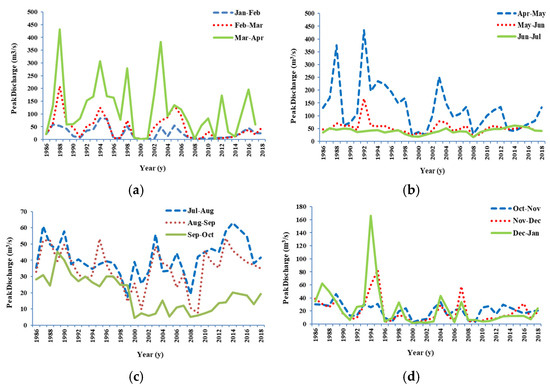
Figure 4.
Seasonal peak discharge at the upstream-33023 station: (a) winter, (b) spring, (c) summer and (d) autumn.
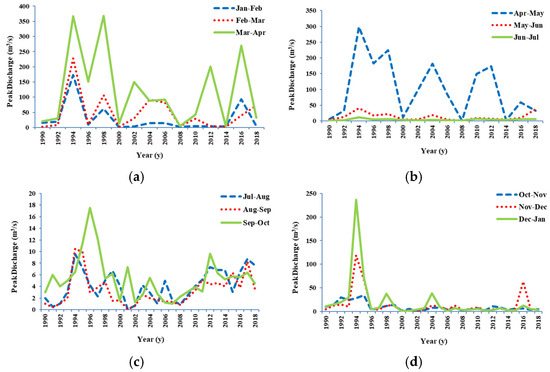
Figure 5.
Seasonal peak discharge at the downstream-33917 station: (a) winter, (b) spring, (c) summer and (d) autumn.
Table 2 indicates that the upstream-33023 station, located 5 km downstream of the Bukan Dam, exhibits peak discharges predominantly in September–October, during early autumn. The statistical relationship between the discharge and the independent variable is captured by a polynomial equation. The R2 value of 0.786 for the upstream-33023 station implies a good fit. The peak discharge behaviour of the upstream-33023 station is likely influenced by controlled releases from the Bukan Dam, which aligns with agricultural water demands and the reduction in reservoir levels post-summer. The sharper fluctuations observed in the upstream hydrograph reflect this controlled response to operational priorities, with limited natural contributions from tributaries. The downstream-33917 station, located 70 km downstream of the Bukan Dam and influenced by the Nowruzlu Dam and eight seasonal tributaries, exhibits a distinct seasonal pattern, with peak discharges occurring in December–January during the winter months. This is indicated by a power equation that achieves a higher R2 value of 0.845, indicating a stronger relationship compared to the upstream station in the time period between the years 1986 and 2018.

Table 2.
Regression analysis of monthly river peak discharge.
3.3. Monthly Precipitation
The temporal evolution of the precipitation at the upstream-33023 station is presented in Figure 6, Figure 7 and Figure 8. The precipitation at the upstream-33023 station peaks in September–October during the early autumn in the 1990s and peaks in April–May during the early spring in the 2000s and 2010s. The R2 values in Table 3 for the regression analysis show a progression over three decades. In the 1990s, the power equation shows a lower predictive accuracy of R2 = 0.661. However, the R2 values for other decades, i.e., the 2000s and 2010s, show a moderate predictive strength and a high predictive reliability, which are 0.719 and 0.829, respectively. The hydrograph peaks in the spring align with the April–May precipitation trends in the 2000s and 2010s, indicating a strong linkage between precipitation events and river discharges. The increasing R2 values over those decades suggest the enhanced predictability of peak discharges, which are potentially influenced by anthropogenic factors such as the regulation of water flows by the Bukan dam at the upstream.

Figure 6.
Precipitation at upstream-33023 station in 1990s: (a) winter, (b) spring, (c) summer (d) autumn.

Figure 7.
Precipitation at upstream-33023 station in 2000s: (a) winter, (b) spring, (c) summer (d) autumn.
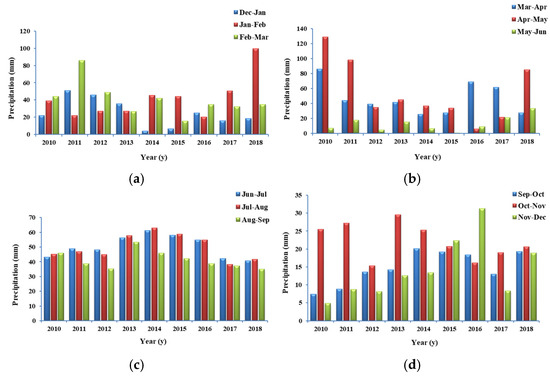
Figure 8.
Precipitation at upstream-33023 station in 2010s: (a) winter, (b) spring, (c) summer (d) autumn.

Table 3.
Regression analysis of monthly precipitation for upstream-33023 station.
In Figure 9, Figure 10 and Figure 11, the precipitation trends are demonstrated for three decades at the downstream-33917 station. Due to those graphs, the R2 values in Table 4 for the regression analysis describe varying degrees of correlation. In the 1990s, the R2 = 0.435 with a polynomial equation, indicating weaker predictive reliability during March–April. In the 2000s, the precipitation data shows a perfect fit for May–June, and in the 2010s, it maintains high predictive reliability during the same period of May–June. The downstream hydrograph peaks during May–June align with the observed precipitation trends, highlighting precipitation as the primary driver of the downstream discharges. The exact fit in the 2000s reflects the regulation of downstream flows by the Nowruzlu Dam, which minimises variability and aligns the discharge patterns with precipitation events.
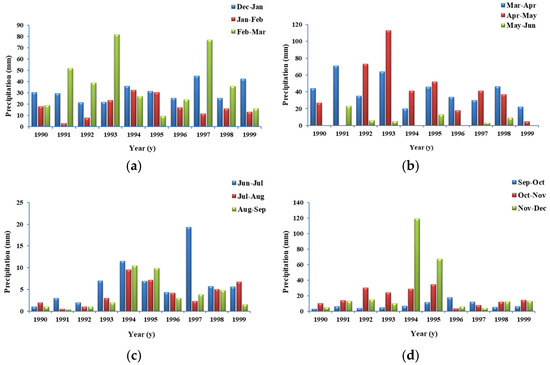
Figure 9.
Precipitation at downstream-33917 station in 1900s: (a) winter, (b) spring, (c) summer and (d) autumn.
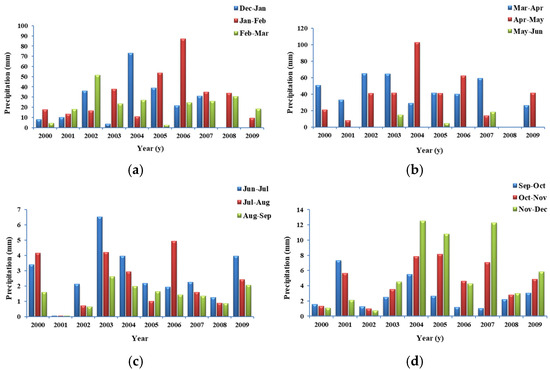
Figure 10.
Precipitation at downstream-33917 station in 2000s: (a) winter, (b) spring, (c) summer (d) autumn.
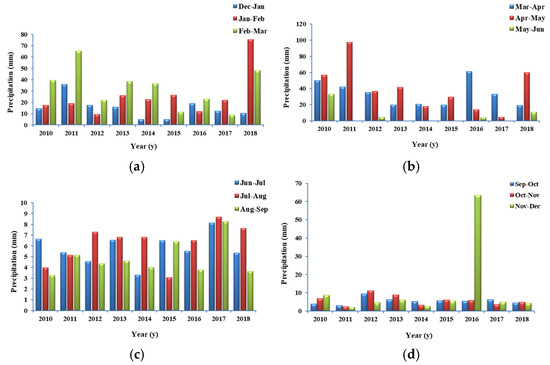
Figure 11.
Precipitation at downstream-33917 station in 2010s: (a) winter, (b) spring, (c) summer (d) autumn.

Table 4.
Regression analysis of monthly precipitation for downstream-33917 station.
The upstream station experienced its peak precipitation earlier in the year during the 1990s (September–October), while the downstream station’s peaks occurred in March–April. This suggests a potential lag in water movement or differing rainfall distribution across the basin. By the 2000s and 2010s, both stations show a shift in peak precipitation to spring months (April–May for upstream and May–June for downstream). This indicates a synchronisation of rainfall trends, possibly influenced by climate change or regional hydrological patterns.
3.4. Monthly Temperature
Figure 12, Figure 13, Figure 14, Figure 15, Figure 16 and Figure 17 represent three recent decades of seasonal temperature analyses that were categorised as the 1990s, 2000s and 2010s for each station separately. Those graphs comprise seasonal monthly temperature data for both the upstream-33023 and downstream-33917 stations. Table 5 shows the regression analysis of the monthly temperature for the upstream-33023 station over three decades. The table highlights the dominant months for temperature peaks and their potential impact on the hydrology of the Zarrinehrud River.
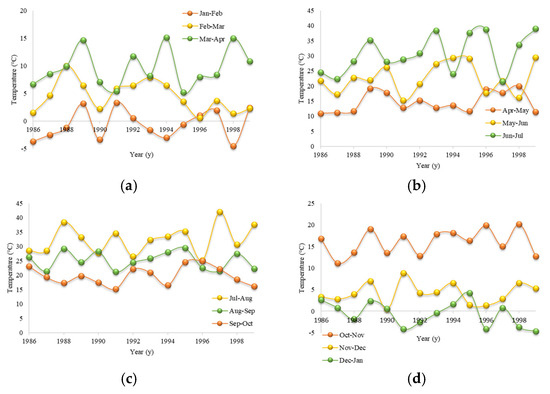
Figure 12.
Temperature at the upstream-33023 in 1990s, (a) Winter, (b) Spring, (c) Summer, (d) Autumn.

Figure 13.
Monthly temperature at the upstream-33023 in 2000s, (a) Winter, (b) Spring, (c) Summer, (d) Autumn.
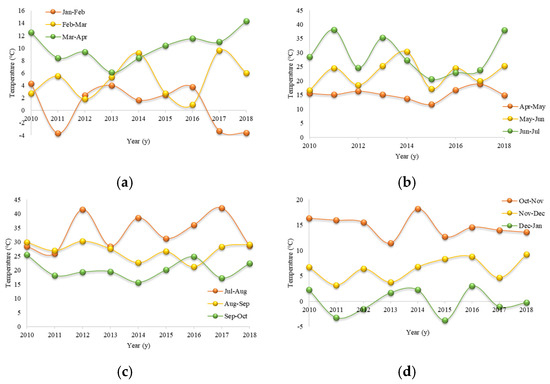
Figure 14.
Monthly temperature at the upstream-33023 in 2010s, (a) Winter, (b) Spring, (c) Summer, (d) Autumn.
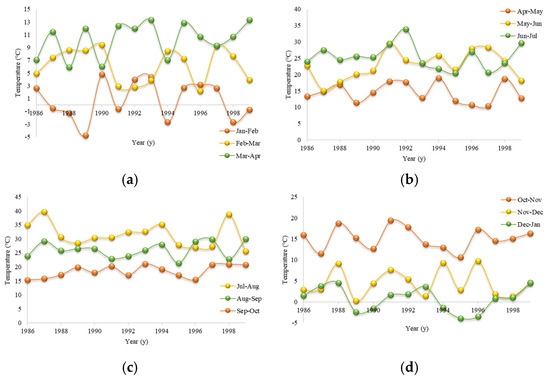
Figure 15.
Monthly temperature at the downstream-33917 in 1990s, (a) Winter, (b) Spring, (c) Summer, (d) Autumn.
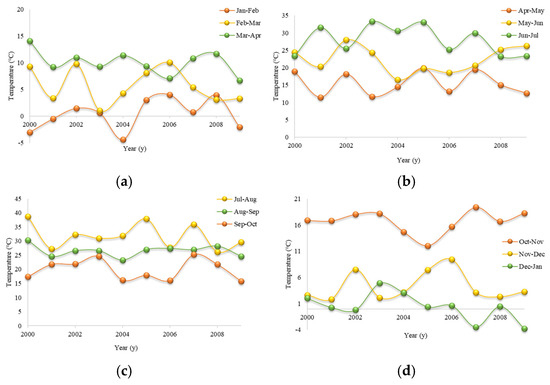
Figure 16.
Monthly temperature at the downstream-33917 in 2000s, (a) Winter, (b) Spring, (c) Summer, (d) Autumn.

Figure 17.
Monthly temperature at the downstream-33917 in 2010s, (a) Winter, (b) Spring, (c) Summer, (d) Autumn.

Table 5.
The regression analysis of the monthly temperatures for the upstream-33023 station.
The temperature trends over the years include the following: (a) 1990s: The highest R2 = 0.818 indicates that the monthly temperature variability during this decade was well-explained by a polynomial equation. The dominant temperature months spanned from September to October, confirming the steady influence of temperature on annual hydrology. (b) 2000s: A lower R2 = 0.668 suggests reduced consistency in the temperature–discharge relationship. The temperature peaks in November–December, reflecting a shift in seasonal patterns or changes in climatic conditions. (c) 2010s: The R2 = 0.748 shows a stronger relationship between temperature and hydrology compared to the 2000s. The dominant months (September–October) suggest that the temperature effects remained impactful throughout the year. The changes in coefficients over decades highlight potential shifts in climatic patterns influencing hydrological processes. The monthly hydrograph for the upstream station shows annual river peak discharges in September–October, coinciding with the dominant temperature months in the 1990s and 2010s. Higher temperatures during the dominant months, particularly in the late summer to early autumn, accelerate snowmelt from upstream catchments. This aligns with the discharge peaks observed in the hydrograph.
Table 6 provides the regression analysis of the monthly temperatures for the downstream-33917 station across three decades. The table includes the statistical equations, the R2 values and the dominant months of temperature variation for each decade. Temperature trends over time include the following: (a) In the 1990s: The highest R2 = 0.839 indicates a strong fit of the quadratic equation, with temperature peaks in July–August, suggesting the influence of summer heat. (b) In the 2000s: A lower R2 = 0.567 points to the weaker predictability of the temperature–discharge relationship. The peaks shifted to April–May, reflecting an earlier onset of high temperatures, which is linked to climate variability. (c) In the 2010s: The R2 = 0.779 shows an improved correlation compared to the 2000s. The peak months remained April–May, indicating a continued trend of springtime temperature dominance. The shift from July–August (1990s) to April–May (2000s and 2010s) indicates earlier warming trends in the basin, which can be attributed to the changing climatic conditions and seasonality in the region. The statistical equations highlight the nonlinear temperature variations over decades, with the coefficients reflecting changes in both temperature magnitude and seasonality.

Table 6.
The regression analysis of the monthly temperature for the downstream-33917 station.
3.5. Statistical Distribution Fitting and Goodness of Fit Test
For reliable analyses in this study, several statistical distribution fittings, including Normal, Lognormal, Gamma and Weibull, are applied to conduct statistical tests, like the Kolmogorov–Smirnov (K–S) test, Anderson–Darling (A–D) test, Mann–Kendall test and Sen’s Slope Estimator, on the historical river peak discharge data as dependent data for both the upstream and downstream stations. To evaluate the suitability of the candidate distributions for modelling the discharge data, the Kolmogorov–Smirnov (K–S) test is summarised in Table 7, including K–S statistics and corresponding p-values for each fitted distribution. Ref. [26] declared that hydrologic variables, including streamflow, are routinely found to possess heavy tails. Therefore, hydrological data, particularly river peak discharges, often exhibit characteristics such as heavy tails and skewness, which can lead to significant deviations from standard theoretical distributions relating to low p-values when conducting goodness of fit tests, as can be seen in Table 7. A smaller K–S statistic indicates a better fit. At the upstream station, the K–S statistics are comparatively lower for all distributions. Notably, the Weibull (0.0901) and Lognormal (0.0962) distributions exhibit the smallest K–S values, suggesting a better approximation of the upstream discharge behaviour relative to the downstream station. At the downstream station, the K–S statistics are generally higher, particularly for the Gamma (0.9313) and Normal (0.4241) distributions, indicating a poorer fit compared to the upstream station. The Lognormal distribution (smallest K–S statistic of 0.1736) outperformed among all distributions in the downstream station.

Table 7.
The statistical Kolmogorov–Smirnov test for the monthly river peak discharge for both stations.
For visual support, the Anderson–Darling (A–D), Mann–Kendall and Sen’s Slope Estimator tests are shown in Figure 18 and Figure 19. The K–S test indicates that discharge at the upstream station is more statistically regular and fits classical distributions better than the discharge from the downstream station, which shows greater irregularity and extreme values. The A–D test suggests that the downstream site displays stronger deviations from normal behaviour, pointing to a more skewed and extreme discharge distribution. According to the Mann–Kendall test trend, the discharge at the upstream station is experiencing a statistically significant downward trend due to changing hydrological conditions. In contrast, the downstream discharge shows no clear long-term trend. Although both stations show negative slopes based on Sen’s Slope Estimator test, only the upstream station’s decline is significant, indicating that hydrological changes are initially detected upstream before they influence downstream conditions.
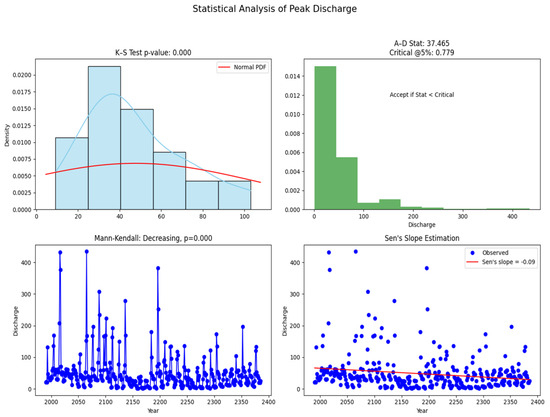
Figure 18.
Statistical analysis of river peak discharge for upstream-33023 station.
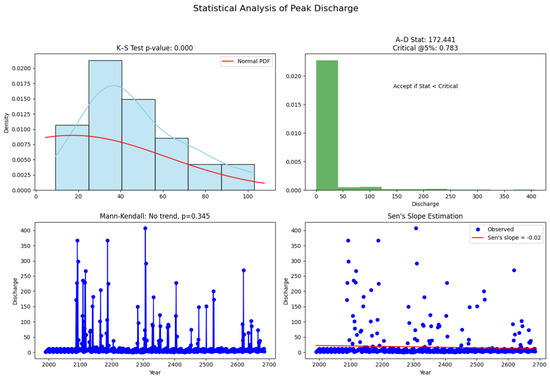
Figure 19.
Statistical analysis of river peak discharge for downstream-33917 station.
The overall results indicate that the annual hydrographs for both stations reveal significant variability in peak discharge over the years, with notable reductions in downstream flow variability that are likely attributable to the regulating effects of the Bukan and Nowruzlu dams. The upstream-33023 station demonstrates greater sensitivity to seasonal precipitation and temperature changes compared to the downstream station, reflected in more pronounced fluctuations. The regression analysis of the monthly peak discharge indicated strong correlations with specific periods: September–October for the upstream site and December–January for the downstream site. These findings are consistent with the hydrograph behaviour, where the upstream discharge peaks earlier due to its proximity to the Bukan Dam, while the downstream discharge reflects cumulative contributions from the watershed, further moderated by the Nowruzlu Dam. Regarding precipitation, the upstream station exhibited peak precipitation during April–May during the 2000s and 2010s, whereas the downstream station showed a consistent shift towards May–June, with the 2000s presenting the strongest correlation (R2 = 1). This temporal offset highlights the spatial and seasonal variations in rainfall distribution across the basin. The temperature regression analysis also revealed seasonal and decadal shifts: the upstream-33023 station demonstrated dominant temperature peaks during September–October (1990s and 2010s) and November–December (2000s), while the downstream-33917 station showed stronger correlations during the summer (July–August in the 1990s) and spring months (April–May in the 2000s and 2010s). These trends suggest that temperature plays a significant role in influencing snowmelt dynamics and evaporation rates, thereby affecting the timing and magnitude of the river discharge. Furthermore, the statistical distribution analysis confirmed that the Weibull distribution best fits the upstream-33023 peak discharge data, while the Lognormal distribution provides the best fit for the downstream-33917 data. This study contains regression analyses (via R2 values) and goodness of fit statistical tests (via p-values) to identify the most critical months for flood forecasting and to recommend suitable statistical distributions for future modelling, respectively.
4. Conclusions
The historical data from the Zarrinehrud River for three decades from 1986 to 2018, including monthly river peak discharge (flow data), precipitation and temperature (climatic data), were used to investigate the river’s behaviour. Due to the rising pace of climate change, human activities and the changing weather paradigm, flood management must be updated to revise the current management method. The upstream-33023 station exhibits earlier precipitation and discharge peaks compared to the downstream station, highlighting the role of topography and proximity to the Bukan Dam. The stronger correlations between precipitation and discharge at the downstream-33917 station suggest cumulative contributions from tributaries and seasonal rivers, compared to the more localised influences at the upstream-33023 station. The highest monthly temperatures at the upstream-33023 station occur during June–July, aligning with the peak of summer. Additionally, in the downstream region, temperature increases can affect the timing and rate of snowmelt from tributaries, contributing to discharge peaks in December–January. As both hydrometric stations are located at a considerable distance from the dam, the direct operational impacts have been minimised in the discharge measurements. Although detailed operational records were unavailable, the statistical analysis of the discharge behaviour remains a valid approach for understanding the managed hydrologic regime for the river system. It is recognised that dam operations, particularly those related to the Bukan dam, significantly influence the natural flow regime of the Zarrinehrud River, impacting the direct correlations between precipitation, temperatures and discharge records. Nevertheless, the objective of this study is not to isolate natural hydro-climatic effects from anthropogenic controls but rather to statistically analyse the historical river discharge, including the effects of dam operation. Applying statistical goodness of fit tests (K–S, A–D) and trend analysis methods (Mann–Kendall and Sen’s Slope) provides valuable insights into the evolving discharge dynamics, capturing both the natural variability and managed flow conditions. Thus, these findings are highly relevant for decision-making under the integrated influence of climate and anthropogenic factors. Consequently, the analysis framework presented in this paper remains applicable for flood forecasting and adaptive management, even under managed river conditions. For further studies, it is recommended to integrate this analysis approach with detailed operational data, where available, to further enhance projections and inform proactive flood mitigation strategies.
Author Contributions
Conceptualization, F.M. and J.H.P.; methodology, F.M. and J.H.P.; software, F.M.; validation, F.M. and J.H.P.; formal analysis, F.M., J.H.P. and O.M.; investigation, F.M., J.H.P., Y.G. and P.R.H.; resources, J.H.P.; data curation, F.M., J.H.P., Y.G., P.R.H., M.M., E.A.-Q. and M.A.M.R.; writing—original draft preparation, F.M.; writing—review and editing, J.H.P., Y.G., P.R.H., O.M., M.M., E.A.-Q. and M.A.M.R.; supervision, J.H.P. and Y.G.; project administration, J.H.P.; funding acquisition, J.H.P. All authors have read and agreed to the published version of the manuscript.
Funding
This research received no external funding.
Institutional Review Board Statement
Not applicable.
Informed Consent Statement
Not applicable.
Data Availability Statement
The raw data will be made available on reasonable request to the corresponding author. This is because this is an ongoing study, and the authors need to keep a record to whom the data has been shared with.
Conflicts of Interest
The authors declare no conflict of interest.
References
- Di Baldassarre, G.; Sivapalan, M.; Rusca, M.; Cudennec, C.; Garcia, M.; Kreibich, H.; Konar, M.; Mondino, E.; Mård, J.; Pande, S.; et al. Stoichiology: Scientific challenges in addressing the sustainable development goals. Water Resour. Res. 2019, 55, 6327–6355. [Google Scholar] [CrossRef]
- Kazemi Garajeh, M.; Haji, F.; Tohidfar, M.; Sadeqi, A.; Ahmadi, R.; Kariminejad, N. Spatiotemporal monitoring of climate change impacts on water resources using an integrated approach of remote sensing and Google Earth Engine. Sci. Rep. 2024, 14, 5469. [Google Scholar] [CrossRef]
- Kordi, F.; Hamzeh, S.; Atarchi, S.; Alavipanah, S.K. Agricultural product classification for optimal water resource management using the data time series of Landsat8. Iran. Ecohydrol. 2018, 5, 1267–1283. [Google Scholar]
- Kazemi Garajeh, M.; Wenget, O.; Haghi, V.; Li, Z.; Garajeh, A.; Salmani, B. Learning-based methods for detection and monitoring of shallow food-affected areas: Impact of shallow food spreading on vegetation density. Can. J. Remote Sens. 2022, 48, 481–503. [Google Scholar] [CrossRef]
- Plate, E.J. HESS Opinions “Classification of hydrological models for flood management”. J. Hydrol. Earth Syst. Sci. 2009, 13, 1939–1951. [Google Scholar] [CrossRef]
- Asadi, S.; Mousavi, S.J.; López-Ballesteros, A.; Senent-Aparicio, J. Analyzing hydrological alteration and environmental flows in a highly anthropized agricultural river basin system using SWAT+, WEAP and IAHRIS. J. Hydrol. Reg. Stud. 2024, 52, 101738. [Google Scholar] [CrossRef]
- AghaKouchak, A.; Norouzi, H.; Madani, K.; Mirchi, A.; Azarderakhsh, M.; Nazemi, A.; Nasrollahi, N.; Farahmand, A.; Mehran, A.; Hasanzadeh, E. Aral Sea syndrome desiccates Lake Urmia: Call for action. J. Gt. Lakes Res. 2015, 41, 307–311. [Google Scholar] [CrossRef]
- Mohammadi, F.; Mhammadi, M.; Behmanesh, J.; Jalili, S. Survey of Groundwater Level Fluctuations by Soft Computing Techniques (Case Study: Urmia and Miandoab Plains). J. Irrig. Water Eng. 2022, 12, 200–219. [Google Scholar]
- Chen, H.; Guo, J.; Xiong, W.; Guo, S.; Xu, C.Y. Downscaling GCMs using the smooth support vector machine method to predict daily precipitation in the Hanjiang Basin. Adv. Atmos. Sci. 2010, 27, 274–284. [Google Scholar] [CrossRef]
- Pu, J.H.; Pandey, M.; Hanmaiahgari, P.R. Analytical modelling of sidewall turbulence effects on streamwise velocity profile using 2D approach: A comparison of rectangular and trapezoidal open channel flows. J. Hydro-Environ. Res. 2020, 32, 17–25. [Google Scholar] [CrossRef]
- Chen, J.; Li, Q.; Wang, H.; Deng, M. A Machine Learning Ensemble Approach Based on Random Forest and Radial Basis Function Neural Network for Risk Evaluation of Regional Flood Disaster: A Case Study of the Yangtze River Delta, China. Int. J. Environ. Res. Public Health 2020, 17, 49. [Google Scholar] [CrossRef] [PubMed]
- Kumar, S.; Singh, H.P.; Balaji, S.; Hanmaiahgari, P.R.; Pu, J.H. Inclusive Hyper- to Dilute-Concentrated Suspended Sediment Transport Study Using Modified Rouse Model: Parametrized Power-Linear Coupled Approach Using Machine Learning. Fluids 2022, 7, 261. [Google Scholar] [CrossRef]
- Toth, E.; Brath, A.; Montanari, A. Comparison of short-term rainfall prediction models for real-time flood forecasting. J. Hydrol. 2000, 239, 132–147. [Google Scholar] [CrossRef]
- Te Linde, A.H.; Aerts, J.C.J.H.; Kwadijk, J.C.J. Effectiveness of flood management measures on peak discharges in the Rhine basin under climate change. J. Flood Risk Manag. 2010, 3, 248–269. [Google Scholar] [CrossRef]
- Supriya, P.; Krishnaveni, M.; Subbulakshmi, M. Regression Analysis of Annual Maximum Daily Rainfall and Stream Flow for Flood Forecasting in Vellar River Basin. Aquat. Procedia 2015, 4, 957–963. [Google Scholar] [CrossRef]
- Shirmohammadi, B.; Malekian, A.; Salajegheh, A.; Taheri, B.; Azarnivand, H.; Malek, Z.; Verburg, P.H. Scenario analysis for integrated water resources management under future land use change in the Urmia Lake region, Iran. Land Use Policy 2020, 90, 104299. [Google Scholar] [CrossRef]
- Behboudian, M.; Kerachian, R. Evaluating the resilience of water resources management scenarios using the evidential reasoning approach: The Zarrinehrud river basin experience. J. Environ. Manag. 2021, 284, 112025. [Google Scholar] [CrossRef]
- Kazemi Garajeh, M.; Feizizadeh, B. A comparative approach of data-driven split-window algorithms and MODIS products for land surface temperature retrieval. Appl. Geomat. 2021, 13, 715–733. [Google Scholar] [CrossRef]
- Kumar, S.; Hanmaiahgari, P.R.; Chowdary, V.M.; Pu, J.H. Geomorphological characteristics of Gandak River between Sahibganj and confluence with Ganga River during 1989–2022. Environ. Earth Sci. 2024, 83, 501. [Google Scholar] [CrossRef]
- Abbasian, M.S.; Najafi, M.R.; Abrishamchi, A. Increasing risk of meteorological drought in the Lake Urmia basin under climate change: Introducing the precipitation–temperature deciles index. J. Hydrol. 2021, 592, 125586. [Google Scholar] [CrossRef]
- Khazaei, B.; Khatami, S.; Alemohammad, S.H.; Rashidi, L.; Wu, C.; Madani, K.; Kalantari, Z.; Destouni, G.; Aghakouchak, A. Climatic or regionally induced by humans? Tracing hydro-climatic and land-use changes to better understand the Lake Urmia tragedy. J. Hydrol. 2019, 569, 203–217. [Google Scholar] [CrossRef]
- Heydari Tasheh Kabood, S.; Hosseini, S.A.; Heydari Tasheh Kabood, A. Investigating the effects of climate change on stream flows of Urmia Lake basin in Iran. Model. Earth Syst. Environ. 2020, 6, 329–339. [Google Scholar] [CrossRef]
- Emami, F.; Koch, M. Evaluation of statistical-downscaling/bias-correction methods to predict hydrologic responses to climate change in the Zarrine River Basin, Iran. Climate 2018, 6, 30. [Google Scholar] [CrossRef]
- Safari, N.; Zarghami, M.; Szidarovszky, F. Nash bargaining and leader–follower models in water allocation: Application to the Zarrinehrud River basin, Iran. Appl. Math. Model. 2014, 38, 1959–1968. [Google Scholar] [CrossRef]
- SNCE. Studies of resources and expenditures of Bukan dam and Zarrinerud irrigation and drainage network. In Sadrab Niroo Consulting Engineers; 2012; 140p. (In Persian) [Google Scholar]
- Katz, R.W.; Parlange, M.B.; Naveau, P. Statistics of extremes in hydrology. Adv. Water Resour. 2002, 25, 1287–1304. [Google Scholar] [CrossRef]
Disclaimer/Publisher’s Note: The statements, opinions and data contained in all publications are solely those of the individual author(s) and contributor(s) and not of MDPI and/or the editor(s). MDPI and/or the editor(s) disclaim responsibility for any injury to people or property resulting from any ideas, methods, instructions or products referred to in the content. |
© 2025 by the authors. Licensee MDPI, Basel, Switzerland. This article is an open access article distributed under the terms and conditions of the Creative Commons Attribution (CC BY) license (https://creativecommons.org/licenses/by/4.0/).